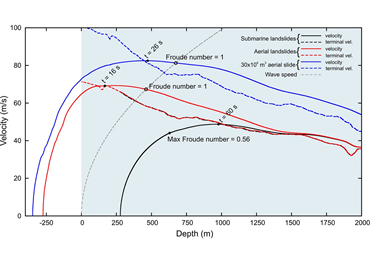Numerical simulation of the tsunamis generated by the Sciara del Fuoco landslides (Stromboli Island, Italy)

Fornaciai A., M. Favalli, L. Nannipieri (2019).
Nature – Scientific Reports, 9.
https://www.nature.com/articles/s41598-019-54949-7#Abs1
Abstract
Stromboli volcano (Aeolian Arc, Italy) experiences many mass failures along the Sciara del Fuoco (SdF) scar, which frequently trigger tsunamis of various sizes. In this work, we simulate tsunami waves generated by landslides occurring in the SdF through numerical simulations carried out in two steps: (i) the tsunami triggering, wave propagation and the effects on Stromboli are simulated using the 3D non-hydrostatic model NHWAVE; (ii) generated train waves are then input into the 2D Boussinesq model FUNWAVE-TVD to simulate wave propagation in the Southern Tyrrhenian Sea (STS). We simulated the following scenarios: (i) the tsunami runup, inland inundation and wave propagation at Stromboli triggered by submarine landslides with volumes of 6, 10, 15 and 20 × 106 m3 and subaerial landslides with volumes of 4, 6, 10 and 30 × 106 m3; (ii) tsunami propagation in the STS triggered by submarine landslides with volumes of 10 and 15 × 106 m3 and by subaerial landslides with volumes of 6 and 30 × 106 m3. We estimate that the damages of the last relevant tsunami at Stromboli, which occurred in 2002, could have been generated either by a subaqueous failure of about 15–20 × 106 m3 along the SdF or/and a subaerial failure of about 4–6 × 106 m3. The coasts most affected by this phenomenon are not necessarily located near the failure, because the bathymetry and topography can dramatically increase the waves heights locally. Tsunami waves are able to reach the first Stromboli populated beaches in just over 1 minute and the harbour in less than 7 minutes. After about 30 minutes the whole Aeolian Arc would be impacted by maximum tsunami waves. After 1 hour and 20 minutes, waves would encompass the whole STS arriving at Capri.


Devi effettuare l'accesso per postare un commento.